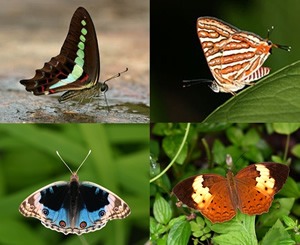
India has one of the richest and most diverse butterfly faunas in the world due to its varied climate and topography. Butterflies feed primarily on nectar from flowers. Some also derive nourishment from pollen, tree sap, rotting fruit, dung, decaying flesh, and dissolved minerals in wet sand or dirt. Flower constancy has been observed for at least one species of butterfly. Butterflies are very active during the day and visit a variety of wildflowers. Butterflies are less efficient than bees at moving pollen between plants. Highly perched on their long thin legs, they do not pick up much pollen on their bodies and lack specialized structures for collecting it. Even though they do not carry as much pollen load as bees, they are capable of moving pollen over greater distances.
Butterflies probe for nectar, their flight fuel, and typically favour the flat, clustered flowers that provide a landing pad and abundant rewards. Butterflies have good vision but a weak sense of smell. Unlike bees, butterflies can see red. Butterflies typically visit flowers that are:
- In clusters and provide landing platforms
- Brightly colored (red, yellow, orange)
- Open during the day
- Ample nectar producers, with nectar deeply hidden
- Nectar guides present
- May be clusters of small flowers (goldenrods, Spirea)
SUPERFAMILY: Hesperioidea
FAMILY: Hesperiidae (Skippers) – 321 species
While some of them feed on grasses, palms, bamboos, ginger and other monocotyledons, others feed on Achyranthes, Terminalia, Grewia, Dalbergia and other such dicotyledons. Most caterpillars feed at night.
SUPERFAMILY: Papilionoidea
FAMILY: Papilionidae (Swallow tails) – 107 species
The caterpillars of various swallowtail butterfly species feed on a wide range of different plants, most depending on only one of five families: Aristolochiaceae (closely related to wild ginger), Annonaceae (custard apple family), Lauraceae (laurel family), Umbelliferae (Apiaceae) (celery, carrot and parsley) and Rutaceae (citrus family). By eating some of these toxic plants, the caterpillars sequester aristolochic acid which renders both the caterpillars and the butterflies of some of these toxic, thus protecting them from predators. Swallowtail tribes Zerynthiini (Parnassiinae), Luehdorfiini (Parnassiinae) and Troidini (Papilioninae) almost exclusively use the Aristolochiaceae family as their host plants.
SUPERFAMILY: Papilionoidea
FAMILY: Pieridae (Whites and Yellows) – 109 species
SUPERFAMILY: Papilionoidea
FAMILY: Nymphalidae (Brush footed butterflies) – 521 species
SUPERFAMILY: Papilionoidea
FAMILY: Lycaenidae (Blues) – 443 species
Caterpillars in this family eat a wider variety of foods than other butterfly families. Some species eat leaves, but others specialize in flowers or fruit. One species is a predator! This is ery rate in butterflies and moths. It feeds on wooly aphids, and females lay their eggs near their insect prey. Some adults sip nectar, but many prefer tree sap or puddles.
Source: 1. http://www.fs.fed.us/wildflowers/pollinators/animals/butterflies.shtml
- http://www.ifoundbutterflies.org/classification/classification-and-checklist-of-indian-butterflies
- Book of Indian Butterflies